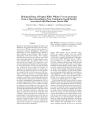Despite its distribution throughout the tropics and subtropics, the pygmy killer whale (Feresa attenuata) is one of the most poorly known species of odontocetes (Cetacea: Delphinidae). We used the opportunity of a mass stranding of six animals in New Caledonia (early February 2006) to gather information about their biology. Four animals, including three males and one female, were found dead, and morphometrics, including dental counts, were collected. Two live mature males of 236 and 246 cm total length (TL), respectively, were closely monitored and sampled via blood analysis. As it was not likely to survive, the second animal was euthanized and necropsied. Following the euthanasia of the larger animal, the smaller one, which was probably staying out of social solidarity, returned on its own to the open sea. The necropsy revealed the presence of cardiopulmonary collapse and enlarged and congested testes. Blood parameters confirmed a deteriorating health status for both animals, enhanced by starvation. Some of the relative morphometric measurements of all six stranded pygmy killer whales seemed to be larger for these animals living in the southwest Pacific as compared to the literature for this species. We hypothesize that this group of pygmy killer whales was probably pushed through the Coral Sea toward the New Caledonian lagoon by Hurricane Jim, which occurred in the area from 26 January until 2 February. These observations reveal January as a potential part of the mating season in this area for this rare, elusive, and unknown species. It also supports the notion that early sacrifice of distressed, terminal animals could be a way to improve the survival rate of other less traumatized individuals during cetacean mass strandings.
Liste




 English
English